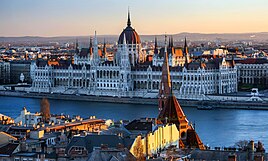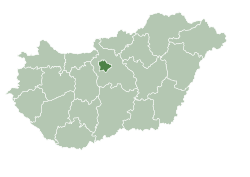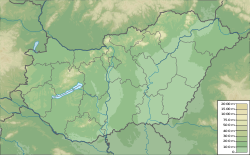
A | B | C | D | E | F | G | H | CH | I | J | K | L | M | N | O | P | Q | R | S | T | U | V | W | X | Y | Z | 0 | 1 | 2 | 3 | 4 | 5 | 6 | 7 | 8 | 9
This article contains too many pictures for its overall length. (May 2024) |
Budapest[8] is the capital and most populous city of Hungary. It is the ninth-largest city in the European Union by population within city limits and it was the largest city on the Danube river;[9][10][11] today it is the second largest one. The city has an estimated population of 1,752,286 over a land area of about 525 square kilometres (203 square miles).[12] Budapest, which is both a city and municipality, forms the centre of the Budapest metropolitan area, which has an area of 7,626 square kilometres (2,944 square miles) and a population of 3,303,786. It is a primate city, constituting 33% of the population of Hungary.[13][14]
The history of Budapest began when an early Celtic settlement transformed into the Roman town of Aquincum,[15][16] the capital of Lower Pannonia.[15] The Hungarians arrived in the territory in the late 9th century,[17] but the area was pillaged by the Mongols in 1241–42.[18] Re-established Buda became one of the centres of Renaissance humanist culture by the 15th century.[19][20][21] The Battle of Mohács, in 1526, was followed by nearly 150 years of Ottoman rule.[22] After the reconquest of Buda in 1686, the region entered a new age of prosperity, with Pest-Buda becoming a global city after the unification of Buda, Óbuda and Pest on 17 November 1873, with the name 'Budapest' given to the new capital.[12][23] Budapest also became the co-capital of the Austro-Hungarian Empire,[24] a great power that dissolved in 1918, following World War I. The city was the focal point of the Hungarian Revolution of 1848 and the Battle of Budapest in 1945, as well as the Hungarian Revolution of 1956.[25][26]
Budapest is a global city with strengths in commerce, finance, media, art, fashion, research, technology, education, and entertainment.[27][28] Hungary's financial centre, Budapest is also the headquarters of the European Institute of Innovation and Technology,[29] the European Police College[30] and the first foreign office of the China Investment Promotion Agency.[31] Over 40 colleges and universities are located in Budapest, including Eötvös Loránd University, Corvinus University, Semmelweis University, University of Veterinary Medicine Budapest and the Budapest University of Technology and Economics.[32][33] Opened in 1896,[34] the city's subway system, the Budapest Metro, serves 1.27 million, while the Budapest Tram Network serves 1.08 million passengers daily.[35]
The central area of Budapest along the Danube River is classified as a UNESCO World Heritage Site and has several notable monuments of classical architecture, including the Hungarian Parliament and the Buda Castle.[36] The city also has around 80 geothermal springs,[37] the largest thermal water cave system,[38] second largest synagogue, and third largest Parliament building in the world.[39] Budapest attracts around 12 million international tourists per year, making it a highly popular destination in Europe.[40]
Etymology and pronunciation
The previously separate towns of Buda, Óbuda, and Pest were officially unified in 1873[41] and given the new name Budapest. Before this, the towns together had sometimes been referred to colloquially as "Pest-Buda".[42][43] Pest is used pars pro toto for the entire city in contemporary colloquial Hungarian.[42]
All varieties of English pronounce the -s- as in the English word pest. The -u in Buda- is pronounced either /u/ like food (as in US: /ˈbuːdəpɛst/[44]) or /ju/ like cue (as in UK: /ˌb(j)uːdəˈpɛst, ˌbʊd-, ˈb(j)uːdəpɛst, ˈbʊd-/). In Hungarian, the -s- is pronounced /ʃ/ as in wash; in IPA: Hungarian: [ˈbudɒpɛʃt] ⓘ.
The origins of the names "Buda" and "Pest" are obscure. Buda was
- probably the name of the first constable of the fortress built on the Castle Hill in the 11th century[45]
- or a derivative of Bod or Bud, a personal name of Turkic origin, meaning 'twig'.[46]
- or a Slavic personal name, Buda, the short form of Budimír, Budivoj.[47]
Linguistically, however, a German origin through the Slavic derivative вода (voda, water) is not possible, and there is no certainty that a Turkic word really comes from the word buta ~ buda 'branch, twig'.[48]
According to a legend recorded in chronicles from the Middle Ages, "Buda" comes from the name of its founder, Bleda, brother of Hunnic ruler Attila.
Attila went in the city of Sicambria in Pannonia, where he killed Buda, his brother, and he threw his corpse into the Danube. For while Attila was in the west, his brother crossed the boundaries in his reign, because he named Sicambria after his own name Buda's Castle. And though King Attila forbade the Huns and the other peoples to call that city Buda's Castle, but he called it Attila's Capital, the Germans who were terrified by the prohibition named the city as Eccylburg, which means Attila Castle, however, the Hungarians did not care about the ban and call it Óbuda and call it to this day.
The Scythians are certainly an ancient people and the strength of Scythia lies in the east, as we said above. And the first king of Scythia was Magog, son of Japhet, and his people were called Magyars after their King Magog, from whose royal line the most renowned and mighty King Attila descended, who, in the 451st year of Our Lord's birth, coming down from Scythia, entered Pannonia with a mighty force and, putting the Romans to flight, took the realm and made a royal residence for himself beside the Danube above the hot springs, and he ordered all the old buildings that he found there to be restored and he built them in a circular and very strong wall that in the Hungarian language is now called Budavár and by the Germans Etzelburg
There are several theories about Pest. One[51] states that the name derives from Roman times, since there was a local fortress (Contra-Aquincum) called by Ptolemy "Pession" ("Πέσσιον", iii.7.§ 2).[52] Another has it that Pest originates in the Slavic word for cave, пещера, or peštera. A third cites пещ, or pešt, referencing a cave where fires burned or a limekiln.[53]
History
Early history
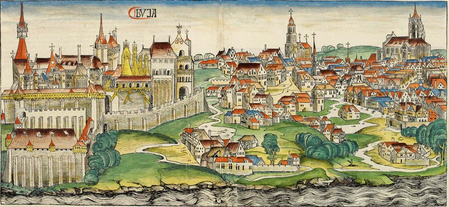
The first settlement on the territory of Budapest was built by Celts[15] before 1 AD. It was later occupied by the Romans. The Roman settlement – Aquincum – became the main city of Pannonia Inferior in 106 AD.[15] At first it was a military settlement, and gradually the city rose around it, making it the focal point of the city's commercial life. Today this area corresponds to the Óbuda district within Budapest.[54] The Romans constructed roads, amphitheaters, baths and houses with heated floors in this fortified military camp.[55] The Roman city of Aquincum is the best-conserved of the Roman sites in Hungary. The archaeological site was turned into a museum with indoor and open-air sections.[56]
The Magyar tribes led by Árpád, forced out of their original homeland north of Bulgaria by Tsar Simeon after the Battle of Southern Buh, settled in the territory at the end of the 9th century displacing the founding Bulgarian settlers of the towns of Buda and Pest,[17][57] and a century later officially founded the Kingdom of Hungary.[17] Research places the probable residence of the Árpáds as an early place of central power near what became Budapest.[58] The Tatar invasion in the 13th century quickly proved it is difficult to defend a plain.[12][17] King Béla IV of Hungary, therefore, ordered the construction of reinforced stone walls around the towns[17] and set his own royal palace on the top of the protecting hills of Buda. In 1361 it became the capital of Hungary.[18][12]
The cultural role of Buda was particularly significant during the reign of King Matthias Corvinus. The Italian Renaissance had a great influence on the city. His library, the Bibliotheca Corviniana, was Europe's greatest collection of historical chronicles and philosophic and scientific works in the 15th century, and second in size only to the Vatican Library.[12] After the foundation of the first Hungarian university in Pécs in 1367 (University of Pécs), the second one was established in Óbuda in 1395 (University of Óbuda).[59] The first Hungarian book was printed in Buda in 1473.[60] Buda had about 5,000 inhabitants around the year 1500.[61]
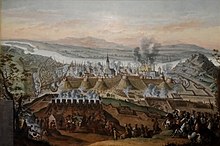
The Ottomans conquered Buda in 1526, as well as in 1529, and finally occupied it in 1541.[62] The Ottoman Rule lasted for more than 150 years.[12] The Ottoman Turks constructed many prominent bathing facilities within the city.[17] Some of the baths that the Turks erected during their rule are still in use 500 years later, including Rudas Baths and Király Baths. By 1547 the number of Christians was down to about a thousand, and by 1647 it had fallen to only about seventy.[61] The unoccupied western part of the country became part of the Habsburg monarchy as Royal Hungary.
In 1686, two years after the unsuccessful siege of Buda, a renewed campaign was started to enter Buda. This time, the Holy League's army was twice as large, containing over 74,000 men, including German, Croat, Dutch, Hungarian, English, Spanish, Czech, Italian, French, Burgundian, Danish and Swedish soldiers, along with other Europeans as volunteers, artillerymen, and officers. The Christian forces seized Buda, and in the next few years, all of the former Hungarian lands, except areas near Temesvár (Timișoara), were taken from the Turks. In the 1699 Treaty of Karlowitz, these territorial changes were officially recognized as the end of the rule of the Turks, and in 1718 the entire Kingdom of Hungary was removed from Ottoman rule.
Contemporary history after Unification
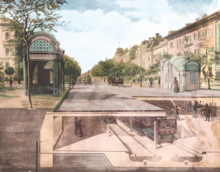
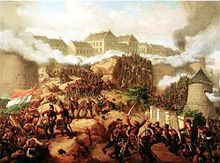
The 19th century was dominated by the Hungarian struggle for independence[12] and modernisation. The national insurrection against the Habsburgs began in the Hungarian capital in 1848 and was defeated one and a half years later, with the help of the Russian Empire. 1867 was the year of Reconciliation that brought about the birth of Austria-Hungary. This made Budapest the twin capital of a dual monarchy. It was this compromise which opened the second great phase of development in the history of Budapest, lasting until World War I. In 1849 the Chain Bridge linking Buda with Pest was opened as the first permanent bridge across the Danube[63] and in 1873 Buda and Pest were officially merged with the third part, Óbuda (Old Buda), thus creating the new metropolis of Budapest. The dynamic Pest grew into the country's administrative, political, economic, trade and cultural hub. Ethnic Hungarians overtook Germans in the second half of the 19th century due to mass migration from the overpopulated rural Transdanubia and Great Hungarian Plain. Between 1851 and 1910 the proportion of Hungarians increased from 35.6% to 85.9%, Hungarian became the dominant language, and German was crowded out. The proportion of Jews peaked in 1900 with 23.6%.[64][65][66] Due to the prosperity and the large Jewish community of the city at the start of the 20th century, Budapest was often called the "Jewish Mecca"[18] or "Judapest".[67][68] Budapest also became an important center for the Aromanian diaspora during the 19th century.[69] In 1918, Austria-Hungary lost the war and collapsed; Hungary declared itself an independent republic (Republic of Hungary). In 1920 the Treaty of Trianon partitioned the country, and as a result, Hungary lost over two-thirds of its territory, and about two-thirds of its inhabitants, including 3.3 million out of 15 million ethnic Hungarians.[70][71]
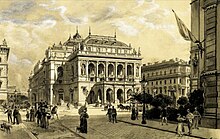
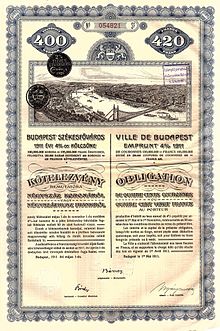


In 1944, a year before the end of World War II, Budapest was partly destroyed by British and American air raids (first attack 4 April 1944[72][73][74]). From 24 December 1944 to 13 February 1945, the city was besieged during the Battle of Budapest. Budapest sustained major damage caused by the attacking Soviet and Romanian troops and the defending German and Hungarian troops. More than 38,000 civilians died during the conflict. All bridges were destroyed by the Germans. The stone lions that have decorated the Chain Bridge since 1852 survived the devastation of the war.[75]
Between 20% and 40% of Greater Budapest's 250,000 Jewish inhabitants died through Nazi and Arrow Cross Party, during the German occupation of Hungary, from 1944 to early 1945.[76]
Swiss diplomat Carl Lutz rescued tens of thousands of Jews by issuing Swiss protection papers and designating numerous buildings, including the now famous Glass House (Üvegház) at Vadász Street 29, to be Swiss protected territory. About 3,000 Hungarian Jews found refuge at the Glass House and in a neighboring building. Swedish diplomat Raoul Wallenberg saved the lives of tens of thousands of Jews in Budapest by giving them Swedish protection papers and taking them under his consular protection.[77] Wallenberg was abducted by the Russians on 17 January 1945 and never regained freedom. Giorgio Perlasca, an Italian citizen, saved thousands of Hungarian Jews posing as a Spanish diplomat.[78][79] Some other diplomats also abandoned diplomatic protocol and rescued Jews. There are two monuments for Wallenberg, one for Carl Lutz and one for Giorgio Perlasca in Budapest.
Following the capture of Hungary from Nazi Germany by the Red Army, Soviet military occupation ensued, which ended only in 1991. The Soviets exerted significant influence on Hungarian political affairs. In 1949, Hungary was declared a communist People's Republic (People's Republic of Hungary). The new Communist government considered the buildings like the Buda Castle symbols of the former regime, and during the 1950s the palace was gutted and all the interiors were destroyed (also see Stalin era). On 23 October 1956 citizens held a large peaceful demonstration in Budapest demanding democratic reform. The demonstrators went to the Budapest radio station and demanded to publish their demands. The regime ordered troops to shoot into the crowd. Hungarian soldiers gave rifles to the demonstrators who were now able to capture the building. This initiated the Hungarian Revolution of 1956. The demonstrators demanded to appoint Imre Nagy to be Prime Minister of Hungary. To their surprise, the central committee of the "Hungarian Working People's Party" did so that same evening. This uprising was an anti-Soviet revolt that lasted from 23 October until 11 November. After Nagy had declared that Hungary was to leave the Warsaw Pact and become neutral, Soviet tanks and troops entered the country to crush the revolt. Fighting continued until mid November, leaving more than 3000 dead. A monument was erected at the fiftieth anniversary of the revolt in 2006, at the edge of the City Park. Its shape is a wedge with a 56 angle degree made in rusted iron that gradually becomes shiny, ending in an intersection to symbolize Hungarian forces that temporarily eradicated the Communist leadership.[80]
From the 1960s to the late 1980s Hungary was often satirically referred to as "the happiest barrack" within the Eastern bloc, and much of the wartime damage to the city was finally repaired. Work on Erzsébet Bridge, the last to be rebuilt, was finished in 1964. In the early 1970s, Budapest Metro's east–west M2 line was first opened, followed by the M3 line in 1976. In 1987, Buda Castle and the banks of the Danube were included in the UNESCO list of World Heritage Sites. Andrássy Avenue (including the Millennium Underground Railway, Hősök tere, and Városliget) was added to the UNESCO list in 2002. In the 1980s, the city's population reached 2.1 million. In recent times a significant decrease in population occurred mainly due to a massive movement to the neighbouring agglomeration in Pest county, i.e., suburbanisation.[81]
In the last decades of the 20th century the political changes of 1989–90 (Fall of the Iron Curtain) concealed changes in civil society and along the streets of Budapest. The monuments of the dictatorship were removed from public places, into Memento Park. In the first 20 years of the new democracy, the development of the city was managed by its mayor, Gábor Demszky.[82]
In October 2019, opposition candidate Gergely Karácsony won the Budapest mayoral election, meaning the first electoral blow for Hungary's nationalist prime minister Viktor Orbán since coming to power in 2010.[83]
Geography
Topography
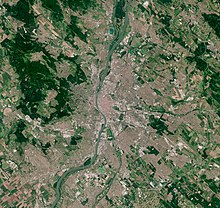
Budapest, strategically placed at the centre of the Pannonian Basin, lies on an ancient route linking the hills of Transdanubia with the Great Plain. By road it is 216 kilometres (134 mi) south-east of Vienna, 545 kilometres (339 mi) south of Warsaw, 1,565 kilometres (972 mi) south-west of Moscow, 1,122 kilometres (697 mi) north of Athens, 1,235 kilometres (767 mi) north-east of Rome, 788 kilometres (490 mi) north-east of Milan, 443 kilometres (275 mi) south-east of Prague, 343 kilometres (213 mi) north-east of Zagreb, 748 kilometres (465 mi) north-east of Split and 1,329 kilometres (826 mi) north-west of Istanbul.[84]
The 525 square kilometres (203 sq mi) area of Budapest lies in Central Hungary, surrounded by settlements of the agglomeration in Pest county. The capital extends 25 and 29 km (16 and 18 mi) in the north–south, east–west direction respectively. The Danube enters the city from the north; later it encircles two islands, Óbuda Island and Margaret Island.[12] The third island Csepel Island is the largest of the Budapest Danube islands, however only its northernmost tip is within city limits. The river that separates the two parts of the city is 230 m (755 ft) wide at its narrowest point in Budapest. Pest lies on the flat terrain of the Great Plain while Buda is rather hilly.[12]
The wide Danube was always fordable at this point because of a small number of islands in the middle of the river. The city has marked topographical contrasts: Buda is built on the higher river terraces and hills of the western side, while the considerably larger Pest spreads out on a flat and featureless sand plain on the river's opposite bank.[85] Pest's terrain rises with a slight eastward gradient, so the easternmost parts of the city lie at the same altitude as Buda's smallest hills, notably Gellért Hill and Castle Hill.[86]
The Buda hills consist mainly of limestone and dolomite, the water created speleothems, the most famous ones being the Pálvölgyi cave (total length 7,200 m or 23,600 ft) and the Szemlőhegyi cave (total length 2,200 m or 7,200 ft). The hills were formed in the Triassic Period. The highest point of the hills and of Budapest is János Hill, at 527 metres (1,729 feet) above sea level. The lowest point is the line of the Danube which is 96 metres (315 feet) above sea level. Budapest is also rich in green areas. Of the 525 square kilometres (203 square miles) occupied by the city, 83 square kilometres (32 square miles) is green area, park and forest.[87] The forests of Buda hills are environmentally protected.[88]
The city's importance in terms of traffic is very central, because many major European roads and European railway lines lead to Budapest.[86] The Danube was and is still an important water-way and this region in the centre of the Carpathian Basin lies at the cross-roads of trade routes.[89] Budapest is one of only three capital cities in the world which has thermal springs (the others being Reykjavík in Iceland and Sofia in Bulgaria). Some 125 springs produce 70 million litres (15,000,000 imperial gallons; 18,000,000 US gallons) of thermal water a day, with temperatures ranging up to 58 Celsius. Some of these waters have been claimed to have medicinal effects due to their high mineral contents.[86]
Climate
Budapest has a humid temperate climate (Köppen: Cfa, Trewartha: Doa), closely bordering on a humid continental climate (Köppen: Dfa, Trewartha: Dca), with warm to hot summers and chilly winters.[90] Winter (November until early March) can be cold and the city receives little sunshine. Snowfall is fairly frequent in most years, and nighttime temperatures of −10 °C (14 °F) are not uncommon between mid-December and mid-February. The spring months (March and April) see variable conditions, with a rapid increase in the average temperature. The weather in late March and in April is often very agreeable during the day and fresh at night. Budapest's long summer – lasting from May until mid-September – is warm or very warm. Sudden heavy showers also occur, particularly in May and June. The autumn in Budapest (mid-September until late October) is characterised by little rain and long sunny days with moderate temperatures. Temperatures often turn abruptly colder in late October or early November.
Mean annual precipitation in Budapest is around 23.5 inches (596.9 mm). On average, there are 84 days with precipitation and 1988 hours of sunshine (of a possible 4383) each year.[91][92][93] From March to October, average sunshine totals are roughly equal to those seen in northern Italy (Venice).
The city lies on the boundary between Zone 6 and Zone 7 in terms of the hardiness zone.[94][95]
| Climate data for Budapest, 1991–2020, (extremes 1870-present) | |||||||||||||
|---|---|---|---|---|---|---|---|---|---|---|---|---|---|
| Month | Jan | Feb | Mar | Apr | May | Jun | Jul | Aug | Sep | Oct | Nov | Dec | Year |
| Record high °C (°F) | 18.1 (64.6) |
20.6 (69.1) |
26.1 (79.0) |
32.0 (89.6) |
34.0 (93.2) |
39.5 (103.1) |
40.7 (105.3) |
40.0 (104.0) |
37.6 (99.7) |
30.8 (87.4) |
23.4 (74.1) |
19.3 (66.7) |
40.7 (105.3) |
| Mean daily maximum °C (°F) | 3.0 (37.4) |
5.8 (42.4) |
11.3 (52.3) |
17.9 (64.2) |
22.6 (72.7) |
26.2 (79.2) |
28.1 (82.6) |
28.0 (82.4) |
22.5 (72.5) |
16.4 (61.5) |
9.4 (48.9) |
3.5 (38.3) |
16.2 (61.2) |
| Daily mean °C (°F) | 0.0 (32.0) |
2.0 (35.6) |
6.6 (43.9) |
12.4 (54.3) |
16.9 (62.4) |
20.7 (69.3) |
22.5 (72.5) |
22.3 (72.1) |
16.9 (62.4) |
11.3 (52.3) |
5.9 (42.6) |
0.8 (33.4) |
11.5 (52.7) |
| Mean daily minimum °C (°F) | −2.5 (27.5) |
−1.3 (29.7) |
2.3 (36.1) |
7.1 (44.8) |
11.6 (52.9) |
15.2 (59.4) |
16.7 (62.1) |
16.6 (61.9) |
12.2 (54.0) |
7.2 (45.0) |
3.1 (37.6) |
−1.4 (29.5) |
7.2 (45.0) |
| Record low °C (°F) | −27.1 (−16.8) |
−25.0 (−13.0) |
−15.5 (4.1) |
−7.2 (19.0) |
−3.3 (26.1) |
0.5 (32.9) |
4.0 (39.2) |
5.0 (41.0) |
−3.1 (26.4) |
−9.5 (14.9) |
−16.4 (2.5) |
−22.0 (−7.6) |
−27.1 (−16.8) |
| Average precipitation mm (inches) | 31 (1.2) |
33 (1.3) |
32 (1.3) |
36 (1.4) |
67 (2.6) |
66 (2.6) |
75 (3.0) |
61 (2.4) |
52 (2.0) |
45 (1.8) |
48 (1.9) |
40 (1.6) |
586 (23.1) |
| Average precipitation days (≥ 1.0 mm) | 6 | 6 | 5.7 | 5.7 | 8 | 6.6 | 6.4 | 5.6 | 5.6 | 6.7 | 7.1 | 6.8 | 76.2 |
| Average relative humidity (%) | 79 | 74 | 66 | 59 | 61 | 61 | 59 | 61 | 67 | 72 | 78 | 80 | 68 |
| Average dew point °C (°F) | −3.9 (25.0) |
−2.3 (27.9) |
0.0 (32.0) |
3.4 (38.1) |
8.3 (46.9) |
11.4 (52.5) |
12.4 (54.3) |
12.4 (54.3) |
10.2 (50.4) |
6.2 (43.2) |
1.9 (35.4) |
−1.8 (28.8) |
4.9 (40.7) |
| Mean monthly sunshine hours | 53.8
Zdroj:https://en.wikipedia.org?pojem=Budapest,_Hungary Text je dostupný za podmienok Creative Commons Attribution/Share-Alike License 3.0 Unported; prípadne za ďalších podmienok. Podrobnejšie informácie nájdete na stránke Podmienky použitia.
Analytika
Antropológia Aplikované vedy Bibliometria Dejiny vedy Encyklopédie Filozofia vedy Forenzné vedy Humanitné vedy Knižničná veda Kryogenika Kryptológia Kulturológia Literárna veda Medzidisciplinárne oblasti Metódy kvantitatívnej analýzy Metavedy Metodika Text je dostupný za podmienok Creative
Commons Attribution/Share-Alike License 3.0 Unported; prípadne za ďalších
podmienok. www.astronomia.sk | www.biologia.sk | www.botanika.sk | www.dejiny.sk | www.economy.sk | www.elektrotechnika.sk | www.estetika.sk | www.farmakologia.sk | www.filozofia.sk | Fyzika | www.futurologia.sk | www.genetika.sk | www.chemia.sk | www.lingvistika.sk | www.politologia.sk | www.psychologia.sk | www.sexuologia.sk | www.sociologia.sk | www.veda.sk I www.zoologia.sk | ||||||||||||

